The Sturmtiger
This Sturmtiger infantry support self propelled mortar gun can be seen at the Deutsches Panzermuseum in the small military town of Munster, Germany. Its production number was Fahrgestell number 250174 and belonged to the Panzer Sturmmörser Kompanie 1002.
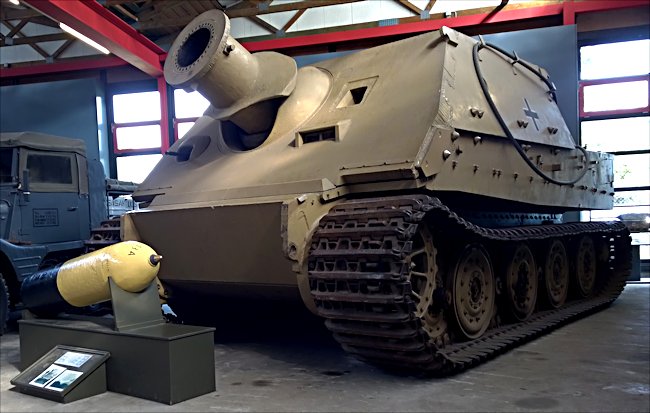
Sturmtiger infantry support self propelled mortar gun at the German Tank Museum. Captured and shiped to the U.S. Army Ordnance Museum. It was then transported back to Germany and was exhibited at the Wehrtechnisches Studiensammlung Koblenz for sometime before finding a new home at the Deutsches Panzermuseum.
The Sturmtiger was only used as intended in Warsaw
When most people think about German armoured vehicles World War II, their thoughts go to the mighty Tiger and the Panther tank. Although these vehicles were the well-known, they were not the most numerous. The less celebrated than these true tanks with revolving 360° turrets were the more important self-propelled artillery guns, assault guns and tank hunters, Jagdpanzers.
They were similar machines as the true tanks, and often did the same job, but they sacrificed the convenience of the turret to be able to mount a larger gun. These guns were carried on the fixed mounting with a limited traverse.
In 1944, during the Battle of the Bulge allies captured a Sturmtiger. The American troops that knocked out this huge at the story must have breathed a sigh of relief. This devastating machine was so powerfully armed, but if you grow out of mere artillery firepower. It was equipped with a mortar of ferocious power. The main armament was a 380mm RW 61 rocket launcher L/5.4. The vehicle had an operational range of only 75 miles (120km). It had a reasonable top speed of 25 mph (40 km/h).
It was designed to attack even the strongest fortification. Due to the range limitations of its main gun, the Sturmtiger had to get very close to its target to fire its payload. It was so heavily armoured that it was nearly impervious to any Allied tank gun or infantry weapon on the battlefield during 1944-45.
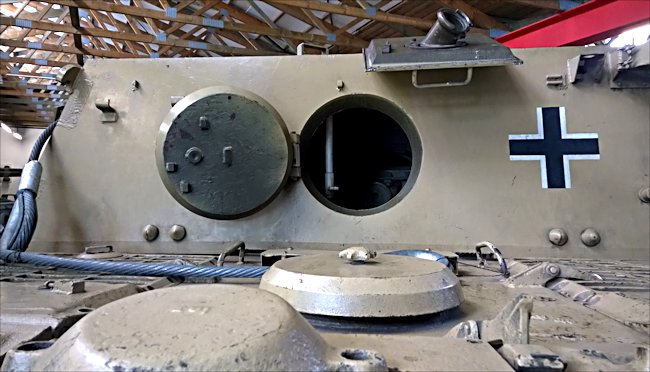
Sturmtiger infantry support self propelled mortar gun at the German Tank Museum
It had 150 mm frontal sloping armour. No Allied weapon could penetrate that protection. The Sturmtiger even had 62mm of armour on its side. The Allied Sherman tank only had 50mm of protective armour on its front. The only thing it was vulnerable to was air attack and heavy artillery fire.
The Sturmtiger's role was to roll up to enemy infantry bunkers, fortified farm buildings, strong points in urban environments, and let leach its mighty round. The chances of survival of enemy combatants sheltering in the target were slim. The enormous shells that it carried was so heavy that the vehicle needed its own crane to load the ammunition.
Once loaded the interior of the Sturmtiger was so crowded that it could only carry enough ammunition for 13 shots. But when it did fire the results were devastating. The Sturmtiger was the last in the line of German army assault guns. This weapon was produced so late in the war the only 19 were produced and saw active service before the war ended.
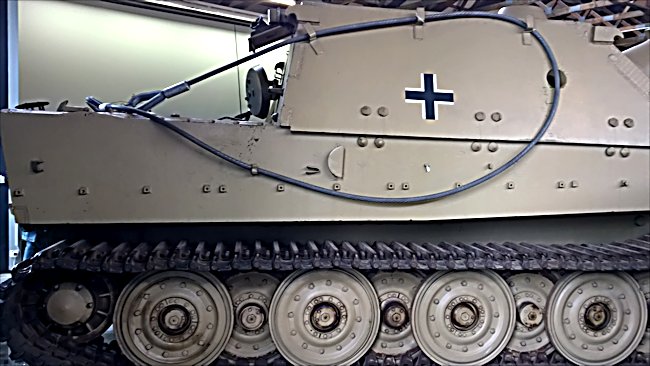
Sturmtiger infantry support self propelled mortar gun at the German Tank Museum
It was a specialist weapon, and like many of the weapons produce in the last years of the war, more trouble than it was worth. It often suffered from mechanical breakdowns. It had a crew of five: driver, machine gun/radio operator, loader, second loader, and tank commander who had access to the top machine gun.
The main reason for the Sturmtiger to be produced was from the German experience the battle of Stalingrad. They found it difficult to remove stubborn Russian machine gun and sniper strong points. They needed an armoured vehicle they could get up close and annihilate the enemy by over whelming use of firepower.
The German army high command created three new Panzer companies that will be issued with the Sturmtiger. They were called Panzer Sturmmörser Kompanien (PzStuMrKp) which in English meant Armored Assault Mortar Company. They were given the prefix numbers of 1000, 1001 and 1002. It had originally been intended to equip each company with 14 Sturmtiger assault guns each. This figure was reduced to only four vehicles per company.
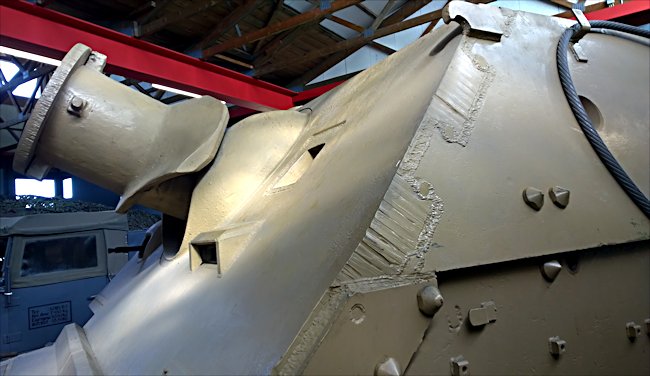
Sturmtiger infantry support self propelled mortar gun at the German Tank Museum
By the time the Sturmtiger appeared on the battlefield the situation had changed to Germany. There were no longer on the attack, apart from the brief Ardennes offensive. They were now defending against attack by the Russian army in the East and the allies in the West. Seven Sturmtigers were used during the Battle of the Bulge as part of Panzer Sturmmörser Kompanien 1001 and 1002.
The only time the Sturmtiger was used for its intended role as a heavy infantry support vehicle that would give assistance during attacks on heavily fortified built-up areas, was during the Warsaw Uprising. PzStuMrKp 1001 was deployed to Warsaw with only two Sturmtigers.
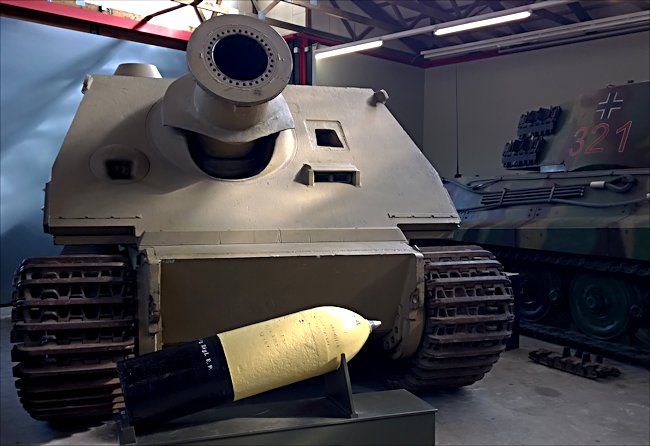
Sturmtiger infantry support self propelled mortar gun at the German Tank Museum
Where can I find other preserved Sturmtiger Assault Guns?
- Bovington Tank Museum, England
- Tank Museum in Kubinka, Russia
- Source - Pierre-Oliver Buan - http://the.shadock.free.fr/Surviving_Panzers.html
WW2 tank books

